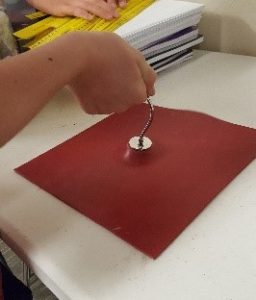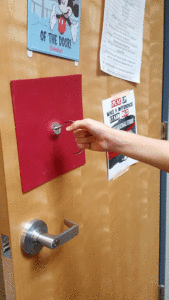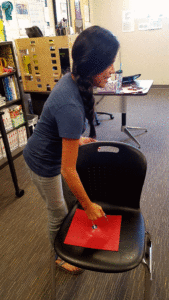 by Nancy Foote
by Nancy Foote
A curiosity table. That’s what I call it. Whenever my students have a free minute (which rarely happens), I encourage them to investigate the materials on the curiosity table in our classroom.
Today I added something new—an Atmospheric Mat.
It was a gift from my good friends at Educational Innovations. This unusual and uniquely shaped article elicited intense curiosity from my students. They wanted to know what it was, how to make it work, what you could use it for, and what science was behind it. “Figure it out,” I told them.
As I watched them explore and experiment, I realized this mat was much more than something to elicit my students’ curiosity. It was a way to teach them what scientists do.
 Students first keyed in on the fact that the texture of the surface the Atmospheric Mat was placed upon mattered. They decided to try to lift a desk. The surfaces of our desks are very smooth; we use them as whiteboards. They could lift the desk a little, but not very much.
Students first keyed in on the fact that the texture of the surface the Atmospheric Mat was placed upon mattered. They decided to try to lift a desk. The surfaces of our desks are very smooth; we use them as whiteboards. They could lift the desk a little, but not very much.
Deciding that it was because of the smoothness of the surface (as opposed to the weight of the desk), they elected to try something a bit rougher. Success. A rougher surface seemed to work better. The fact that the second object was lighter was not obvious to them.
Next they decided to try the hallway floor, given that it is concrete and supposedly rougher. Obviously they were not trying to lift the floor, but rather to see how hard they needed to pull on the mat before it came loose. The floors in our hallway are sealed, which makes them relatively smooth. This meant that the floor did not give them much more information about how the Atmospheric Mat worked.
 To get back into the room from the hallway, students needed to open the door. Why not see whether the Atmospheric Mat had the ability to open the door? This trial was followed by hoots and yells as the door opened.
To get back into the room from the hallway, students needed to open the door. Why not see whether the Atmospheric Mat had the ability to open the door? This trial was followed by hoots and yells as the door opened.
This prompted a huge influx of questioning. Students tested the mat on the wall. They tested it on the board. They tested it on their iPads (which did not work, because the iPads are too small). Would they reach a point where the surface was too rough?
Each test gave additional data, which led to additional questions about how and why the Atmospheric Mat works. They even tried using it upside down, expecting that it would behave like a suction cup.
As you can see, this is an incredible tool for studying forces and atmospheric pressure… and more. At some point I’ll bring up the fact that there are no “sucking” forces in science. We’ll figure out together that the roughness of the surface isn’t what makes it hard to pull off an object—it’s atmospheric pressure.
 For now, the Atmospheric Mat is a tool that I’m going to continue using to ignite my students’ curiosity. I’m going to let my students explore it for as long as they want. Their exploration won’t be driven by me; their curiosity will be what drives them.
For now, the Atmospheric Mat is a tool that I’m going to continue using to ignite my students’ curiosity. I’m going to let my students explore it for as long as they want. Their exploration won’t be driven by me; their curiosity will be what drives them.
At the end of the day, when it was time to stack our chairs, one of my students asked me if she could use the Atmospheric Mat to lift her chair onto the top of the pile. “Give it a try,” I said. She was delighted when it worked, and worked very well.
“Hey, Mrs. Foote,” she said after the chairs were stacked, “I feel like a scientist today.”
“You are!” I told her. And it was all due to the Atmospheric Mat that I put on the curiosity table.
Nancy Foote is a middle school physics teacher in Arizona. She is a recipient of the Presidential Award for Excellence in Mathematics and Science Teaching, as well as an Arizona master teacher. Nancy’s YouTube channel can be found at www.YouTube.com/nancyfootehigley.
